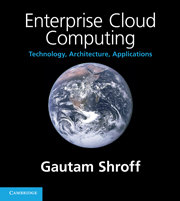Book contents
- Frontmatter
- Contents
- Preface
- List of abbreviations
- Part I Computing platforms
- Chapter 1 Enterprise computing: a retrospective
- Chapter 2 The internet as a platform
- Chapter 3 Software as a service and cloud computing
- Chapter 4 Enterprise architecture: role and evolution
- Part II Cloud platforms
- Part III Cloud technologies
- Part IV Cloud development
- Part V Software architecture
- Part VI Enterprise cloud computing
- References
- Index
Chapter 3 - Software as a service and cloud computing
Published online by Cambridge University Press: 06 December 2010
- Frontmatter
- Contents
- Preface
- List of abbreviations
- Part I Computing platforms
- Chapter 1 Enterprise computing: a retrospective
- Chapter 2 The internet as a platform
- Chapter 3 Software as a service and cloud computing
- Chapter 4 Enterprise architecture: role and evolution
- Part II Cloud platforms
- Part III Cloud technologies
- Part IV Cloud development
- Part V Software architecture
- Part VI Enterprise cloud computing
- References
- Index
Summary
EMERGENCE OF SOFTWARE AS A SERVICE
Even during the early days of the internet it had become evident that software products could be packaged and sold as remotely hosted ‘application services.’ A number of ASPs (application service providers) were born (such as Corio), for the most part offering the same software packages as enterprises used within their data centers, but in a hosted model wherein the software ran within the ASPs' data centers with users accessing it over the internet. For a variety of reasons this first wave of ASPs did not succeed. First, the internet bandwidth was simply not adequate at that time. Second, since most of the popular software products, such as ERP and CRM systems, were client-server applications, ASPs resorted to the highly inefficient practice of ‘screen scraping’ to enable remote access to these applications, using remote-desktop-sharing mechanisms (such as Citrix MetaFrame) that essentially transmitted screen-buffer images back and forth over the network. More importantly, the early ASPs were simply not structured to offer significant cost advantages over the traditional model; they had to pay similar license fees to the providers of packaged software while being unable to add sufficient value through economies of scale.
A notable early exception was Intuit with its successful hosted offering of QuickBooks, a desktop accounting solution. This was soon followed by the success of Salesforce.com and its hosted CRM (customer relationship management) solution.
- Type
- Chapter
- Information
- Enterprise Cloud ComputingTechnology, Architecture, Applications, pp. 27 - 38Publisher: Cambridge University PressPrint publication year: 2010



